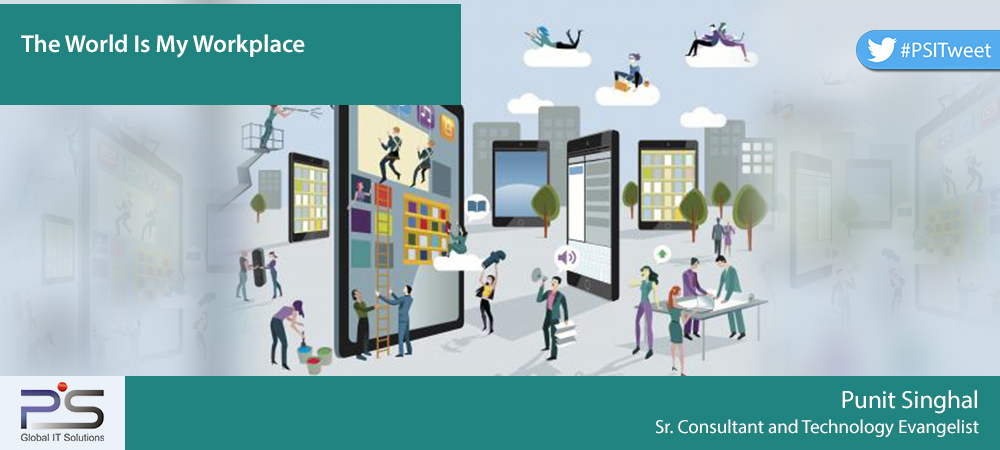
Our workplace has definitely evolved over the last few decades. It began with companies connecting the employees together via networks, next came the internet connecting computers to the world and now we have entered the Mobility and Digital workplace phase.
It has become more adaptable and compatible according to the nature of our work. Earlier IT support was considered a mere infrastructure component for an organization; but now it’s a strategic element of any company. Moreover, the Digital workplace concept entails strategic decisions for effective employee engagement offering a comfortable computing zone.
Present day work essentials like mobility, cross-device compatibility, social media accessibility and global collaboration cannot be addressed within the traditional workplace scenario. It has to adopt off-beat workplace environment, which is user / employee-friendly and more responsive to the user’s requirements.
Let’s understand, what a Digital Workplace imply?
- Digital workplace requires a broader and open IT perspective. It is important to implement new IT services and support for a wide range of devices along with a renewed HR policy supporting the same.
- Digital Workplace breaks monotony of a traditional work environment enabling a more liberal perspective towards employees and work.
- Most importantly it brings enhanced customer / employee experience facilitating the use of latest devices & applications.
- Emergence of cloud services positions workplace as a digital hub by combining cloud and in-house services.
- Technology is the game changer for this transformation in the workplace scenario.
The social and mobile technologies are widely adapted by the employees and are becoming an inseparable element of any business environment.
The digital dimension is at the core of all functional and business challenges and involves modernising the work environment, managing the digital technologies, optimizing capital costs along with relevant end-user experience. The transformation into digital workplace is a sustainable and evolving phenomenon.
For instance, innovative products like Google glass, iWatch, connected objects, 3D printing, Wi-Fi printing is increasingly being used in IT organisations. However, in the interest of organisational growth; IT teams needs to check excessive use of gadget and simplify it for mass adoption.
Assessing the current company’s development stage will help in understanding the gap and strategise the way forward accordingly. The key focus areas are:
- Evaluate the Strategy and Ownership; the level of top management& HR team’s commitment for adopting digital workplace.
- Understand devices and mobility factor; the status of devices available with the company and mobility concerns.
- Application and Cloud services; consider adopting Emerging Technologies in business activities
- Evaluate Data & system security; the network capabilities with respect to security concerns
- Collaborative services; the interlinking and consistency of the technology solutions
- Understand the User; the design and level of services required
In addition, the organization needs to have a corporate architecture to support the Digital workplace. They need to incorporate new platform solutions for implementing latest operating systems, redesign the employee work atmosphere by leveraging the social media and cloud services along with mobility services, optimise processes through BPM and real time analysis and most importantly by integrating all IT services for BYOD.
Prior to setting a digital workplace framework, the organization must resolve any and every challenge related to governance, risk and compliance. The framework must support connectivity and participation from all and at the same time considers the risk and enables compliance.
I believe HR has the power to spearhead this entire revamp and bring about a collaborative change in the process of adopting a Digital Workplace. Moreover, for any organization it is important to involve the Legal department to pull down the risk factor and make the Digital Workplace framework fool-proof.Our workplace has definitely evolved over the last few decades. It began with companies connecting the employees together via networks, next came the internet connecting computers to the world and now we have entered the Mobility and Digital workplace phase.
It has become more adaptable and compatible according to the nature of our work. Earlier IT support was considered a mere infrastructure component for an organization; but now it’s a strategic element of any company. Moreover, the Digital workplace concept entails strategic decisions for effective employee engagement offering a comfortable computing zone.
Present day work essentials like mobility, cross-device compatibility, social media accessibility and global collaboration cannot be addressed within the traditional workplace scenario. It has to adopt off-beat workplace environment, which is user / employee-friendly and more responsive to the user’s requirements.
Let’s understand, what a Digital Workplace imply?
- Digital workplace requires a broader and open IT perspective. It is important to implement new IT services and support for a wide range of devices along with a renewed HR policy supporting the same.
- Digital Workplace breaks monotony of a traditional work environment enabling a more liberal perspective towards employees and work.
- Most importantly it brings enhanced customer / employee experience facilitating the use of latest devices & applications.
- Emergence of cloud services positions workplace as a digital hub by combining cloud and in-house services.
- Technology is the game changer for this transformation in the workplace scenario.
The social and mobile technologies are widely adapted by the employees and are becoming an inseparable element of any business environment.
The digital dimension is at the core of all functional and business challenges and involves modernising the work environment, managing the digital technologies, optimizing capital costs along with relevant end-user experience. The transformation into digital workplace is a sustainable and evolving phenomenon.
For instance, innovative products like Google glass, iWatch, connected objects, 3D printing, Wi-Fi printing is increasingly being used in IT organisations. However, in the interest of organisational growth; IT teams needs to check excessive use of gadget and simplify it for mass adoption.
Assessing the current company’sdevelopment stage will help in understanding the gap and strategise the way forward accordingly. The key focus areas are:
- Evaluate the Strategy and Ownership; the level of top management& HR team’s commitment for adopting digital workplace.
- Understand devices and mobility factor; the status of devices available with the company and mobility concerns.
- Application and Cloud services; consider adoptingEmerging Technologies in business activities
- Evaluate Data & system security; the network capabilities with respect to security concerns
- Collaborative services; the interlinking and consistency of the technology solutions
- Understand the User; the design and level of services required
In addition, the organization needs to have a corporate architecture to support the Digital workplace. They need to incorporate new platform solutions for implementing latest operating systems, redesign the employee work atmosphere by leveraging the social media and cloud services along with mobility services, optimise processes through BPM and real time analysis and most importantly by integrating all IT services for BYOD.
Prior to setting a digital workplace framework, the organization must resolve any and every challenge related to governance, risk and compliance. The framework must support connectivity and participation from all and at the same time considers the risk and enables compliance.
I believe HR has the power to spearhead this entire revamp and bring about a collaborative change in the process of adopting a Digital Workplace. Moreover, for any organization it is important to involve the Legal department to pull down the risk factor and make the Digital Workplace framework fool-proof.[:]








